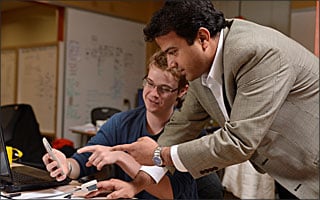Engineering innovations reshape global health

Engineering is a field with the power to transform lives across the globe, often in the most underserved regions. Nowhere is this maxim more apparent than at the Center for Bioengineering Innovation & Design (CBID), founded in 2007 at the Johns Hopkins University’s Department of Biomedical Engineering.
Each summer, teams of new engineering graduate students travel overseas to areas where poverty and poor healthcare dominate. They look for opportunities to put their skills to work solving difficult, and often deadly, health problems.
“CBID is training the next generation of engineering innovators in the best way possible, by sending them into the field to seek out new ideas,” says Soumyadipta Acharya, MD, MSE, PhD, the graduate program director of CBID and an assistant research professor in the Department of Biomedical Engineering.
One example points up the promise of the program. For many underserved populations, the challenge is not necessarily the cost of care but simply the travel required to reach medical treatment facilities. Seeing the problem repeatedly in expectant mothers, one CBID team of students created a simple, in-home urine test for detection of preeclampsia, a dangerous complication during pregnancy, which, if undiagnosed, can threaten both the mother and fetus. Each test costs just one-third of a penny.
Those students work in teams and are supported by funding from organizations such as USAID and Johns Hopkins-affiliate Jhpiego, by corporate partners such as Laerdal Global Health, and Medtronic, and by non-profits like the GE foundation, and Gates Foundation. They spend a month overseas in challenged locations in Southeast Asia (Nepal, India), and Sub-Saharan Africa (Kenya, Tanzania, Ethiopia), where they learn and absorb everything they can about the public health issues.
“They are trained to ask: What are the gaps in care? Why is this happening? Where can I help?” Acharya says.
Returning to Baltimore, the teams develop and fine-tune prototypes, often led by mentors from industry, the Johns Hopkins School of Medicine, and Jhpiego. During the next two semesters, they return to the field with their prototypes for real-world testing. “It’s very iterative,” Acharya asserts.
The prototypes often lead to clinical products with the potential to change and even save lives. The areas of impact stretch from prenatal and maternal care to deadly diseases like tuberculosis and cancer.
This year’s projects, exhibited on May 6 at the 2014 BME Design Day, held at the Johns Hopkins medical campus, featured innovations aimed at detecting neonatal hypothermia, monitoring fetal heart rates, identifying maternal anemia, and treating cardiac arrhythmia.
“CBID is taking valuable, often extremely affordable health care directly to the patients who benefit most. It’s the perfect intersection of engineering creativity and meaningful impact,” Acharya says.
— Andrew Myers
